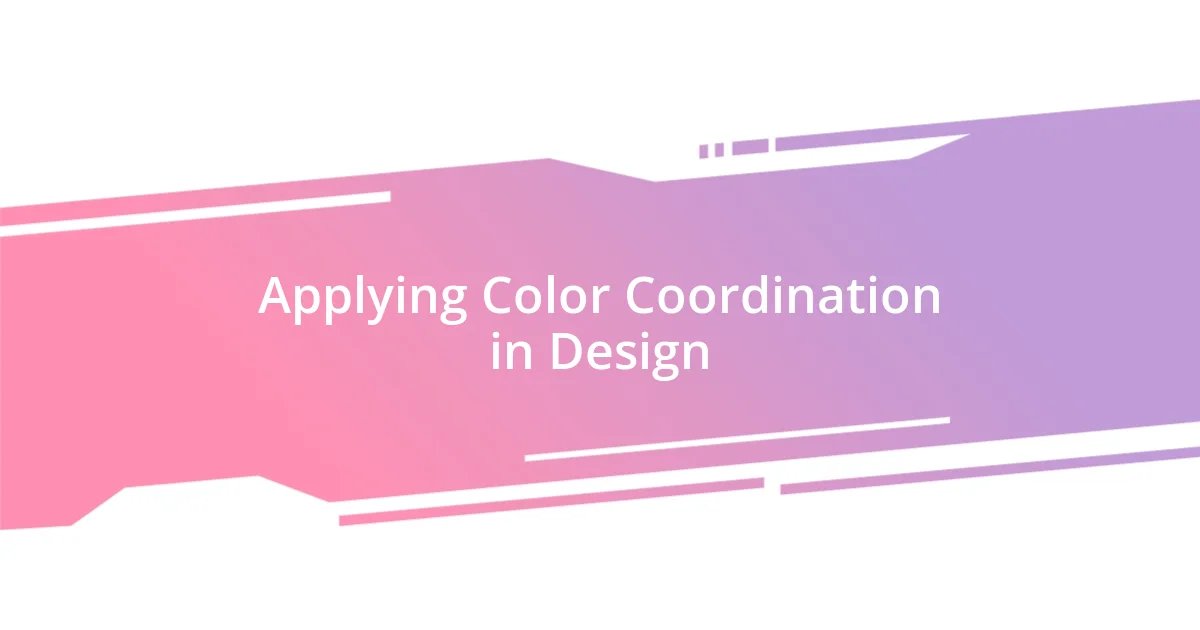Key takeaways:
- Color theory aids in understanding color interactions, enhancing emotional responses and overall design aesthetics.
- Utilizing strategies such as the 60-30-10 rule and experimenting with textures can create visually appealing and harmonious spaces.
- Avoid common mistakes like overcomplicating palettes and neglecting to test colors under different lighting conditions to achieve desired effects.

Understanding Color Theory
Color theory is a fascinating blend of science and art that helps us understand how colors interact with each other. I remember the first time I played with a color wheel in art class; it was like discovering a new language. This wheel illustrates the relationships between colors, highlighting primary, secondary, and tertiary hues, which can inform everything from the clothes we wear to how we decorate our homes.
As I explored color combinations, I became aware of how certain colors evoke specific emotions; for example, blues often bring a sense of calmness while reds can generate excitement. Have you ever noticed how a warm, sunny palette can lift your spirits on a gray day? In my experience, using color strategically can transform not just a space but also our mood and energy levels.
Understanding complementary colors—those directly opposite each other on the color wheel—has been a game changer in my approach to coordination. I once used a vibrant orange with a deep blue in a room, instantly creating a dynamic yet balanced atmosphere. It’s incredible how experimenting with these combinations can lead to unexpected beauty and harmony in both our personal and professional lives.

Basics of Color Coordination
Color coordination lays the groundwork for creating beautiful design, be it in fashion or interior spaces. I still recall the time I decided to redecorate my bedroom, choosing colors based not just on preference but understanding their roles. I ended up combining soft pastels for the walls with a few bold accent pieces. The result? A serene retreat that felt alive and inviting.
A few essential principles can greatly enhance your approach to color coordination:
- Monochromatic Schemes: Using different shades of a single color can create a soothing, cohesive look. I love how varying hues of green can give a natural and fresh ambiance.
- Analogous Colors: Colors that sit next to each other on the color wheel blend harmoniously. They can evoke a sense of calm, like the soft transition from yellow to orange in a sunset.
- Contrasting Colors: Employing contrasting shades can make elements pop. I personally enjoy the punch of deep purples against bright yellows for an eye-catching effect.
- Warm vs. Cool Colors: Understand the emotional responses that warm (reds, oranges) and cool (blues, greens) colors elicit, helping you curate the mood you desire.
These foundations have guided my explorations, leading to some delightful surprises and the discovery of what truly resonates with me. Would you consider trying some of these techniques in your next color adventure?

Choosing a Color Palette
Choosing the right color palette can be the backbone of any design endeavor. From my experiences, I’ve learned that starting with a small selection of colors can make the process more manageable. I often begin by selecting one dominant color that speaks to me—a color that I feel a strong emotional connection with—and then build the rest of the palette around it, creating a harmonious foundation.
When I was working on a living room makeover, choosing a palette was a pivotal moment. I initially envisioned a bold yet cozy atmosphere, so I started with a deep forest green as the main color. To complement it, I added soft beige and warm rust tones. The combination not only reflected my personality but also made the space feel inviting and vibrant. Have you ever picked a color that just makes your heart sing? That’s the magic of finding your palette!
It’s crucial to also consider the context of your palette. The lighting in a room can drastically alter how colors appear. During one of my projects, I painted a small office space a cheerful yellow, only to find that in the afternoon sun, it took on a glaring intensity that felt overwhelming. In retrospect, I would have blended it with softer tones to maintain the intended bright yet peaceful ambience. It’s a good reminder that experimentation, along with careful observation, can lead to the most desirable results in any color coordination journey.
| Color Palette Style | Description |
|---|---|
| Monochromatic | Utilizing variations of a single color to create a calm atmosphere. |
| Analogous | Choosing colors next to each other on the wheel for a harmonious feel. |
| Contrasting | Incorporating opposite colors for bold visual interest. |

Using Color Wheel for Guidance
The color wheel has been my trusted companion for navigating the sometimes overwhelming world of color coordination. When I’m uncertain about which hues to combine, I refer back to the wheel, allowing it to guide my choices. For instance, I distinctly remember my struggle while planning my kitchen’s color scheme. By using the color wheel, I realized that pairing the earthy tones of terracotta with soft blues would create a warm and inviting atmosphere, making cooking feel less like a chore and more like a cozy gathering.
I find that understanding the relationships between colors—like complementary, analogous, or triadic combinations—can be eye-opening. Have you ever found yourself drawn to a specific color but didn’t know what to pair it with? There was a time when I fell in love with a vibrant magenta but felt lost on how to incorporate it into my home. By exploring the wheel, I discovered that soft greens would not only balance the intensity but also add a refreshing twist. This balance made me appreciate the contrast, creating an invigorating yet harmonious space.
What really excites me about the color wheel is its ability to spark creativity. While planning a friend’s outdoor wedding, I used the wheel to craft a stunning palette that reflected both their personalities and the season. By selecting shades of coral, teal, and muted gold, I not only captured the essence of summer but also created an enchanting ambiance that left everyone in awe. Using the color wheel transformed what could have been a mundane task into an exciting creative endeavor—don’t you think there’s something magical about that?

Practical Tips for Matching Colors
When it comes to matching colors, one practical tip I often rely on is the 60-30-10 rule. This technique allows me to create balance and visual interest in my spaces. For example, during a bedroom renovation, I painted the walls a soft blue (60%), used a darker navy for the bed linens (30%), and tossed in vibrant yellow pillows and accessories (10%). The result was not just pleasing to the eye but also sparked joy every time I walked into the room.
Another approach I appreciate is mixing textures along with colors. This strategy brings depth to a color palette that can sometimes fall flat. I once styled my office with a blend of matte greens, a glossy yellow lamp, and a plush gray rug, which transformed the space into an inviting and dynamic environment. Have you ever considered how a variety of textures can elevate the colors you’re working with? Pairing colors with different materials can create a dialogue in your space, inviting you to touch, feel, and experience the atmosphere more fully.
Lastly, I suggest testing colors in various lighting conditions before committing. I used to shy away from bold hues, thinking they’d overwhelm my space. However, when I painted a small accent wall a daring teal, I discovered that, under soft evening light, it radiated a cozy warmth that completely transformed the mood. This little experiment taught me that the right lighting can make even the boldest choices feel just right. So, when picking your palette, don’t forget to consider how colors will interact with different types and angles of light throughout the day.

Common Mistakes in Color Coordination
One of the most common mistakes I see in color coordination is overcomplicating the palette. Early on, I fell into this trap while decorating my living room. I was so excited about mixing colors that I ended up with a chaotic blend of shades that just didn’t gel. It felt overwhelming and disjointed. Sometimes, less really is more. Have you ever stepped back and realized that simpler combinations often feel the most harmonious?
Another significant blunder is neglecting to consider the context in which colors are used. I remember a time when I painted my bathroom a bright orange, thinking it would be invigorating. However, because the space is small and lacks natural light, it was more overwhelming than refreshing. It’s essential to think about how colors will impact the space and your mood. When choosing a color, ask yourself: will it create the atmosphere I desire in this particular setting?
Lastly, failing to use samples can lead to harsh surprises. I once impulsively bought a bold purple paint for my dining room, convinced it would create an elegant vibe. But when I finally applied it, I found it made the room feel like a dark cave instead of a chic dining area. Trust me, testing paints or fabrics in your actual space is crucial. Have you ever experienced a similar letdown? Always make sure to observe colors at different times of the day to see how they truly manifest in your living environment.

Applying Color Coordination in Design
Applying a thoughtful color coordination approach in design can dramatically alter the perception of a space. I vividly recall when I curated a color palette for my kitchen renovation. I chose a cool minty green for the cabinetry, paired with crisp white countertops and warm wooden accents. The combination not only made the space feel airy and inviting but also energized me every time I stepped in to cook. Have you ever experienced how the right colors can uplift your mood and enhance your daily routines?
In my design journey, I’ve explored the psychological effects of color, which adds another layer of depth to my choices. For instance, I opted for a serene lavender in my reading nook to promote relaxation and creativity. This soothing hue created a perfect backdrop for cuddling up with a book. I often ask my friends, what feelings do you want to evoke in a room? Understanding the emotions behind colors can guide you in making decisions that resonate personally.
Experimentation can be incredibly rewarding. One time, I decided to paint a small bathroom in a bold coral, thinking it would add vibrancy. To my surprise, it transformed the space from drab to delightful while providing an unexpected pop. This experience polished my belief that taking risks with color can lead to extraordinary results. Have you ever pushed your boundaries with color that paid off in ways you never imagined? Embracing bold choices often leads to delightful surprises in design.














